October 14th Scots Book of Days
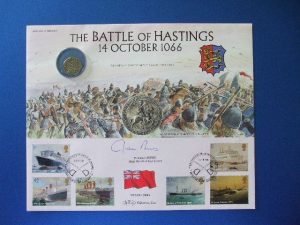 October 14 – 1066 – Battle of Hastings,
October 14 – 1066 – Battle of Hastings,
2004 OCEAN LINERS SIGNED + COIN FDC -THE BATTLE OF HASTINGS SHS.
Lord de Bosville, Clan Boswell, a Lowland Scottish clan. Many Normans would eventually settle in Scotland, along with Anglo saxon refugees.
- Boswell of Auchinleck Ayr 13c 2Arnot2Colville 2Semple 2Montgomerie2Cochrane 2Miller2Simmons 2Choate zoe ToaG
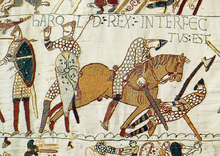 One of the Norman commanders Jardine, Clan Jardine, a lowland Scottish clan, is contained in Hollingshead’s Chronicles of England as one of the Norman knights that fought for William at Hastings, and the Norman conquest of England. Battle Abbey Roll -a list of William the Conqueror’s companions.
One of the Norman commanders Jardine, Clan Jardine, a lowland Scottish clan, is contained in Hollingshead’s Chronicles of England as one of the Norman knights that fought for William at Hastings, and the Norman conquest of England. Battle Abbey Roll -a list of William the Conqueror’s companions.
Harold Rex Interfectus Est: “King Harold is killed”. Scene from the Bayeux Tapestry depicting the Battle of Hastings. Harold grasps the arrow lodged in his eye.
In the 1050s, Edward the Confessor, King of England, received Malcolm Canmore (Malcolm 3rd) in exile at Edward’s court after Macbeth killed Malcolm’s father, Duncan I, and seized the Scottish throne. In 1054 Edward sent Siward to invade Scotland. Siward defeated Macbeth, and Malcolm 3rd, who had accompanied the expedition, gained southern Scotland. By 1058 Malcolm had killed Macbeth and became King of Scots. In 1059 Malcolm visited Edward. In 1061 Malcolm raided Northumbria, an ancient Scot’s custom. Malcolm 3rd married Margaret of Wessex (Saint Margaret of Scotland or Queen Margaret of Scotland). Margaret was the great niece of Edward the Confessor, and heir to the Anglo Saxon royal line which dated to the 4th century, and fled to Scotland after the Norman invasion. Margaret’s and Malcolm’s descendants include all the English (from William 2nd) and Scottish royal lines since, mixing the ancient Scots, Anglo Saxon and Viking Danish Norman French lines. Thus the importance of the Norman Conquest.
1318 Battle of Faughart, (battle of Dundalk). county Louth, Ireland. First War of Scottish Independence. Sir John Stewart, Edward Bruce killed.
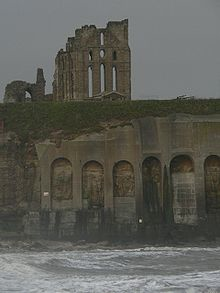 1322 Battle of Old Byland,, Yorkshire, England. The Battle of Old Byland (also known as the Battle of Byland Moor and Battle of Byland Abbey) was a significant encounter between Scots and English troops in Yorkshire in October 1322. Robert the Bruce of Scotland defeated King Edward II of England at Byland, forming part of the First War of Scottish Independence.
1322 Battle of Old Byland,, Yorkshire, England. The Battle of Old Byland (also known as the Battle of Byland Moor and Battle of Byland Abbey) was a significant encounter between Scots and English troops in Yorkshire in October 1322. Robert the Bruce of Scotland defeated King Edward II of England at Byland, forming part of the First War of Scottish Independence.
Tynemouth Priory, seen from the sea where Isabella escaped the Scots army following the disastrous campaign of 1322.
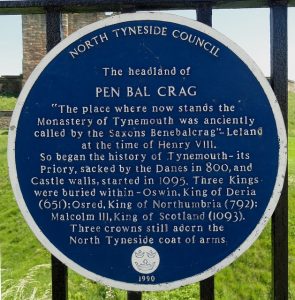 openplaques.org/plaques/785. The headland of Pen Bal Crag. “The place where now stands the Monastery of Tynemouth was anciently called by the Saxons Benelbalcrag” – Leland at the time of Henry VIII. So began the history of Tynemouth – its Priory, sacked by the Danes in 800, and Castle walls, started in 1095. Three Kings were buried within – Oswin, King of Deria(651): Osred, King of Northumbria (792); Malcolm III, King of Scotland (1093). Three crowns still adorn the North Tyneside coat of arms.
openplaques.org/plaques/785. The headland of Pen Bal Crag. “The place where now stands the Monastery of Tynemouth was anciently called by the Saxons Benelbalcrag” – Leland at the time of Henry VIII. So began the history of Tynemouth – its Priory, sacked by the Danes in 800, and Castle walls, started in 1095. Three Kings were buried within – Oswin, King of Deria(651): Osred, King of Northumbria (792); Malcolm III, King of Scotland (1093). Three crowns still adorn the North Tyneside coat of arms.
- Brus or Bruce 1050 2Stewart2Kennedy 2Montgomery2Blair 2Cochrane2Miller 2Simmons2Choate zoe ToaG
1467 Sir Lawrence Oliphant was created a Lord of Parliament by King James 2nd or King James 3rd, with an uncertain Honour. Sir Lawrence, sat in Parliament as a Lord of Parliament on the 14th of October 1467, and the Peerage must have been created before that time. The Dignity descended in regular succession to Lawrence the 5th Lord Oliphant, who succeeded his grandfather, Lawrence the 4th Lord, in 1593, his father, the Master of Oliphant, perished at sea in 1584. The principle of law, that a Peerage of Scotland of unknown origin shall be presumed to be limited to the heirs male of the body of the Grantee, had not been established by a decision or otherwise in the 17th Century; Lawrence Lord Oliphant’s daughter Anne was wife of Sir James I Douglas of Mordington. By a Procuratory of Resignation Lawrence resigned his Peerage in favour of Patrick Oliphant his next heir male, desiring to ensure the continuance of his Dignity in the male line of his family. But Lawrence’s Resignation does not appear to have been accepted by the King, and certainly no regrant followed upon it. Lord Oliphant died before the year 1631.
- Douglas 1036 2Stewart 2Ruthven 2Kinchin 2Jared 2Simmons 2Choate – Douglas 2Montgomberie 2Blair 2Cochrane 2Miller 2Simmons 2Choate – Douglas 2Hamilton 2Stewart 2Miller 2Simmons 2Choate – Douglas 2Carlyle 2Semple 2Montgomery 2Cochrane 2Miller 2Simmons 2Choate
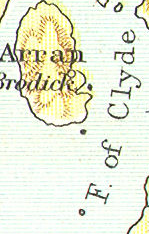 1482 James (2nd Lord Boyd) (c. 1469–1484), grandson and heir of Robert Boyd, 1st Lord Boyd being only son of Thomas Boyd, Earl of Arran, by Mary, eldest daughter of James II of Scotland, on the death of his grandfather, Robert, although a minor James became titular head of the Boyd family. James was restored to his lands 14 October 1482, but has been generally supposed by Peerage writers not to have been restored to his honours. killed in a feud with Hugh Montgomery of Eglintoun in 1484, when he must have been under sixteen.
1482 James (2nd Lord Boyd) (c. 1469–1484), grandson and heir of Robert Boyd, 1st Lord Boyd being only son of Thomas Boyd, Earl of Arran, by Mary, eldest daughter of James II of Scotland, on the death of his grandfather, Robert, although a minor James became titular head of the Boyd family. James was restored to his lands 14 October 1482, but has been generally supposed by Peerage writers not to have been restored to his honours. killed in a feud with Hugh Montgomery of Eglintoun in 1484, when he must have been under sixteen.
- Boyd Lord Kilmarnock Ayr 1020 2Douglas2Ruthven 2Kinchin2Jared2Simmons 2CHoate zoe ToaG
Isle of Arran in the Firth of Clyde.
1574, Leith on Firth of Forth. A Plague arrives from England, several died before existence was known. October 14th A History of Epidemics in Britain from A.D. 664 to the Extinction of Plague Charles Creighton, M.A. M.D. Demonstrator of Anatomy University of Cambridge. 1891
1582– Because of the implementation of the Gregorian calendar this day does not exist in this year in Italy, Poland, Portugal and Spain.
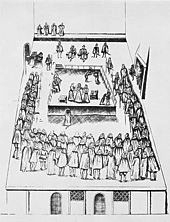 1586 – Mary, Queen of Scots, goes on trial for conspiracy against Elizabeth I of England Commissioners (33-178)held their court in the great hall of Fotheringhay castle, Northampton, England, to try Queen Mary for treason.
1586 – Mary, Queen of Scots, goes on trial for conspiracy against Elizabeth I of England Commissioners (33-178)held their court in the great hall of Fotheringhay castle, Northampton, England, to try Queen Mary for treason.
- Trial of Mary, Queen of Scots, in Fotheringhay castle, 14, 15 October 1586 Yelverton Manuscripts
1591 John Lindsay of Balcarres (1552–1598) Lord Menmuir, Angus, appointed one of the four financial managers for Anne of Denmark. In July 1593 he was named one of a special council for the management of the queen’s revenues, and in January 1595 he was chosen one of the eight commissioners of the exchequer, known as Octavians.
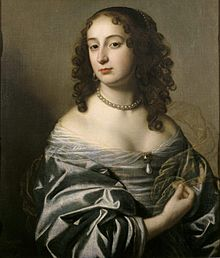 1630 Birth of Sophia of Palatinate, Sophia of Hanover, Electress of Hanover from 1692 to 1698. (Ancestress of Scots and English Royalty from 1714) Daughter of Frederick V elector Palatine and Elizabeth of Scotland (1596-1662) daughter of James VI of Scots and I of England and Ireland and Anne of Denmark.
1630 Birth of Sophia of Palatinate, Sophia of Hanover, Electress of Hanover from 1692 to 1698. (Ancestress of Scots and English Royalty from 1714) Daughter of Frederick V elector Palatine and Elizabeth of Scotland (1596-1662) daughter of James VI of Scots and I of England and Ireland and Anne of Denmark.
Electress of Hanover, Sophia of Hanover. (1692-1698). Currently, there are more than 5,000 legitimate descendants of Sophia, although not all are in the line of succession. The Sophia Naturalization Act 1705 granted the right of British nationality to Sophia’s non-Roman Catholic descendants;[13][14] those who had obtained the right to British citizenship via this Act at any time before its repeal by the British Nationality Act 1948 retain this lawful right today. Wikipedia/
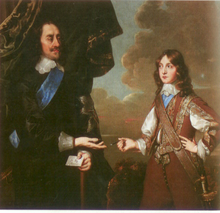 1633 James 2nd (of England) and 7th (of Scotland) born, son of Charles (later the 1st). James was brother of Charles 2nd (died 1685). James Reigned 1685 to 1688.
1633 James 2nd (of England) and 7th (of Scotland) born, son of Charles (later the 1st). James was brother of Charles 2nd (died 1685). James Reigned 1685 to 1688.
James with his father, Charles 1st.
Tytler’s History of Scotland from Encyclopaedia Britannica at 214 (1845) notes for 1685. In protest against the reign of James 2nd ‘The Earl of Argyle, with Sir Patrick Hume, Sir John Cochrane, and other Scottish exiles, to the number of about three hundred, sailed from Holland with three vessels laden with arms and ammunition, and landed in Kentire in the West Highlands, where they were joined by a thousand men belonging to the clan Campbell.’
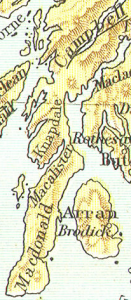 Kintire is a peninsula in this Western Highlands of Scotland,due west of the Isle of Arran, marked by the Macdonald, Macalister, Knapdale and Campbell families.
Kintire is a peninsula in this Western Highlands of Scotland,due west of the Isle of Arran, marked by the Macdonald, Macalister, Knapdale and Campbell families.
Argyle’s insurrection failed with the army taken captive. [Argyle] ‘himself was taken prisoner near Renfrew, carried to Edinburgh, and after suffering many indignities, was executed on his former iniquitous sentence. Upwards of twenty of the most considerable gentlemen of his clan, and a number of his Lowland followers, were put to death for their share in this transaction. During the alarm created by Argyle’s invasion, the privy council ordered all the Covenanters who were in prison to be sent to the north for their more safe custody. After a toilsome march, during which they were subjected to the greatest hardships and indignities, they reached the place of their destination, the castle of Dunnottar, where, to the number of one hundred and sixty persons, including several women and children, they were thrust into a large naked dungeon. Their guards allowed them neither bedding nor provisions, excepting what they bought, and made them pay for every indulgence, even that of water. Many of them died in consequence of this horrid confinement, and the shocking tortures to which they were subjected. At the end of six weeks or two months, the survivors had the test offered to them : those who agreed to take it were discharged; those who refused were transported to the plantations.’ [American southern colonies]
1715 – Macintosh marched on Edinburgh. [TG68-310]
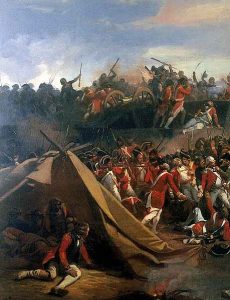 1781 Battle of Yorktown. 71st Fraser’s Highlanders (disbanded at the end of the war). Americans storming the redoubts on 14th October 1781 during the Battle of Yorktown.
1781 Battle of Yorktown. 71st Fraser’s Highlanders (disbanded at the end of the war). Americans storming the redoubts on 14th October 1781 during the Battle of Yorktown.
1806 Jena. Bonaparte defeated Prussian army. Tytler’s Britannica 265. French hot air observation balloons provide tactical advantage, observing the adage, ‘control the high ground.’
1881 Eyemouth fishing fleet storm disaster, Scotland, (14 October 1881).
1884 – The American inventor George Eastman, received a U.S. Government patent on his new paper-strip photographic film. Hollywood is next to be invented.
1939 Returning to Scapa Flow after guarding the Fair Isle passage during a recent sortie by battlecruiser “Gneisenau”, and now at anchor, battleship “ROYAL OAK” was torpedoed and sunk by “U-47” (Lt-Cdr Prien) in the early hours of the 14th with the loss of 833 men. The Home Fleet moved to Loch Ewe on the W Scottish coast
1942 HM Queen Mary, Cunard Line, built Clydebank Scotland, converted to troopship. To November 2, 1942 Dry docked in Boston Naval Shipyard to install a new more permanent bow piece.
2012 Humor. Crawford, having been gone awhile, was retreating from one of the occasional battles his clan fought, and passed out from exhaustion and his wounds, within site of his home. As he recovered on the table, his wife stood over him. She asked, “Would ye like some food?” Crawford croaked, “Yea, please, Ah haven’t eaten a bite for a week ane Ah am very hungry!” She disappeared and quickly came back with a basket of food. After eating, she asked, “Would ye like something to drink?” ” Oh, yes! Ah would very much like a drink!” She went again and returned with a refreshing drink. Crawford dreamed he died and had gone to heaven, when his wife leaned closer and whispered, “When ye get yer strength, would you like to play around?” “Oh, you beautiful woman, don’t tell me we’ve got a golf course here too, now!” http://www.fife.50megs.com/scottish-humor2.htm
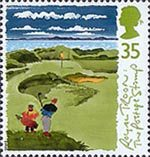 1994 Scottish Golf Courses Commemorative stamp. The 8th Hole (‘The Postage Stamp’), Royal Troon, South Ayrshire, Scotland.
1994 Scottish Golf Courses Commemorative stamp. The 8th Hole (‘The Postage Stamp’), Royal Troon, South Ayrshire, Scotland.
2014 Britain’s First woman Prime Minister. Margaret Thatcher.
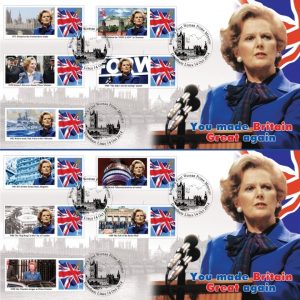 Margaret Hilda ROBERTS (Baroness) THATCHER
Margaret Hilda ROBERTS (Baroness) THATCHER
(Prime Minister; first woman to lead British party; longest serving British P.M. of 20th century; eponym of Thatcherism; Knight of the Garter) Born: Grantham 13 Oct 1925 Died: 8 Apr 2013 London. Fabpedigree.com (clan Bosworth, Rushbrook of Scotland.
Disclaimer: The author of each article published on this web site owns his or her own words. The opinions, beliefs and viewpoints expressed by the various authors and forum participants on this site do not necessarily reflect the opinions, beliefs and viewpoints of Utah Standard News or official policies of the USN and may actually reflect positions that USN actively opposes. No claim in public domain or fair use. © John Choate.
Utah Standard News depends on the support of readers like you.
Good Journalism requires time, expertise, passion and money. We know you appreciate the coverage here. Please help us to continue as an alternative news website by becoming a subscriber or making a donation. To learn more about our subscription options or make a donation, click here.
To Advertise on UtahStandardNews.com, please contact us at: ed@utahstandardnews.com.


Comments - No Responses to “October 14th Scots Book of Days”
Sure is empty down here...